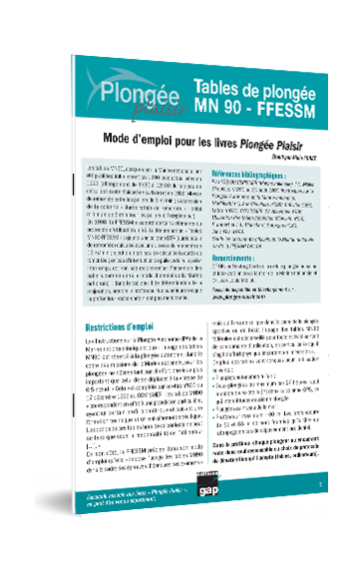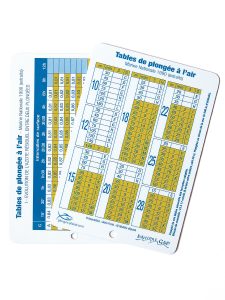
- Publisher: 8 p.
- Editor: GAP editions
- Editing: Reserved for Plongée Plaisir members. Free registration, see Member Area.
- Available in: pdf, download
Presentation
In the age of dive computers, used by almost 100% of divers, the use of dive tables is still taught. This makes it possible to better understand how a desaturation model works and thus to know the limits of the instruments. They can also be useful in addition to computers as a rescue procedure.
Here we present thehe manual for the MN90-FFESSM dive tables, in its integral version.
Marine Nationale user manual and FFESSM user manual, what are the differences?
The MN90 tables, designed by the French Navy, have been published:
- initially in 1990 (PV n ° 03/90 CEPISMER, Dr J.-L. Méliet and Circular n ° 280 of August 20, 1990);
- updated in 1993 by extending the table for calculating residual nitrogen at the surface from 8:30 a.m. to 12:00 p.m. (Amendment n ° 1 to Circular n ° 280, February 9, 1993);
- updated in 1996 by adopting an ascent rate between stages of 6 m / min, by deleting the column “total ascent time” and by providing for a minimum delay of 5 min for stages with pure oxygen (Letter n ° 630, COMISMER, December 17, 1996).
The specific protocols, such as what to do in the event of a rapid ascent or stop of a plateau, are not part of the MN90 tables but their instructions for use and are therefore not specific to the MN90 tables (see Procedure for rapid ascent).
As a result, the claim spread on social networks, according to which: “It MUST be clarified that this procedure is not compatible with the indications of our dive computers because in this case there is a mixture of TWO desaturation procedures for the same dive and it's serious! " is false.
Simply download the publication of Dr Jean-Louis Méliet creating the MN90 tables to see that the instructions for use of the tables are not part of the dive tables. Moreover, the French Navy has modified the instructions for use without the tables being modified. In addition, the operating instructions for Bühlmann tables (FSSS) as well as Annex I of 05/24/2019 on hyperbaric regulation (MT92 tables - Comex) recommend this mid-depth re-immersion procedure for 5 min in the event of a rapid ascent. Finally, a computer (often with a Bühlmann algorithm) does its calculations without considering the procedures used. The notion of alleged “incompatibility” of procedures is therefore meaningless. The only question to ask is whether the procedure carried out is dangerous or not for the human body.
In 1998-1999, the FFESSM has adapted certain elements of the protocol for use, hence the name “Tables MN90-FFESSM” (Use of federal tables, CTN Info n ° 29, F. Imbert and J.-L. Blanchard, Subaqua n ° 162, Jan-Feb 1999):
- addition of a total ascent time column (ascent speed: 15 m / min);
- addition of a table for calculating the total ascent time;
- in the event of an interruption of the level, repeat the interrupted level (and not restart all the levels as in the instructions for use by the French Navy);
- in Table II for determining the increase, take the upper depth read when the desired depth is not mentioned.
Since 2009, the French Navy's Autonomous Diving Instructions (IPA) have been modified. In particular, the notion of “safety stop” has been added (IPA-1 page v.7-1). A "safety stop" must be carried out in the event of intense efforts or yo-yo dives (if the depth of the dive is greater than 10 m; beyond 2 yo-yo during the dive; with limitation strict at 6 yo-yos per 24-hour period):
- The decompression profile to be observed is that of the duration immediately greater than the duration of work performed. In the event of a successive dive, it is also necessary for the calculation of the GPS to take into account the duration immediately greater than the duration of work performed.
- In all cases, a stop of one minute at 6 meters followed by another of 5 minutes at 3 meters are at least performed.
In addition, in the event of a rapid ascent, the French Navy now asks, after applying the half-depth re-immersion procedure for 5 minutes, to perform at least one minute of stops at 6 meters and 5 minutes at 3 meters. (instead of the 2 min minimum at 3 m required before 2009).
Thanks : CF Olivier NASTORG Head of CEPHISMER of the French Navy, Lieutenant of Vessel Maxime ALBERT Head of the “Risk Management” section ALFAN / CEPHISMER and Dr Jean-Louis Méliet.
The Plongée Plaisir books refer to the instructions for use (which remains unchanged to this day) of the FFESSM, the delegated federation for the practice of recreational diving. Only the official documents of the French Navy or the FFESSM are authentic.
Contents of the COMPLETE manual for dive tables
- Restrictions on use;
- The main conventions (diving time, maximum depth, etc.);
- The notion of ascent rate;
- “Simple” or “unit” or “isolated” dives;
- “Successive” dives;
- “Consecutive” (dangerous) dives;
- Lead it to hold in the event of a slow ascent;
- Have it hold in the event of a rapid (dangerous) ascent;
- Lead it to hold in the event of a (dangerous) level interruption;
- Dives at altitude;
- The use of oxygen (bearings, surface interval);
- Using the tables while breathing nitrox (oxygen enriched air).
Contents of the SIMPLIFIED dive tables user manual
- Restrictions on use;
- The main conventions (diving time, maximum depth, etc.);
- The notion of ascent rate;
- “Simple” or “unit” or “isolated” dives;
- “Successive” dives;
- “Consecutive” (dangerous) dives;
- Lead it to hold in the event of a slow ascent;
- Have it hold in the event of a rapid (dangerous) ascent;
- Guide it to hold in the event of a (dangerous) level interruption.
Downloading
This manual for the MN90-FFESSM dive tables can be downloaded free of charge.
MN90 submersible dive tables

Also find the MN90 submersible tables, useful even with dive computers in emergency procedures.
2 double-sided submersible tables for air dives indicating:
- the depth and duration of the stops according to the maximum depth reached and the time spent (ascent rate 15 to 17 m / min);
- the evolution of residual nitrogen between two dives;
- the increase in minutes for successive dives.
These submersible dive tables have been specially designed to:
- Easily fit in your waistcoat pocket (9 cm x 13 cm);
- Be very legible, including underwater (colors, fonts and font sizes);
- Be useful with a judicious choice of diving times and depths, in line with the logic of recreational dives, without encumbering them unnecessarily with times / depths hardly ever used (eg 55 min at 60 m) or without issues (eg . 15 min at 8 m).
You can buy these submersible submersible tables by clicking here.
Sujets liés :
- The concept of levels
- Mandatory levels
- Interruption of mandatory levels
- Optional levels (called “safety”)
- Increase the duration of the stages
- Perform the step from 3 m to 6 m?
- Deep landings
- “Pyle stops”
A question, a suggestion, talk to the author, Alain FORET: Click here.
